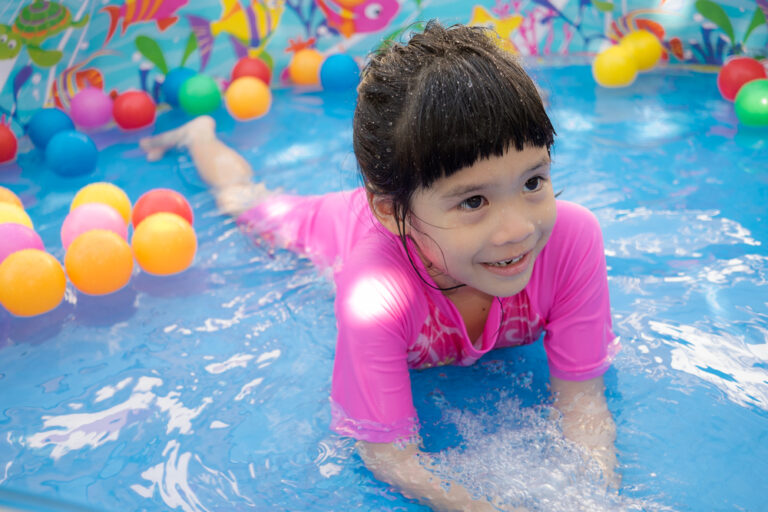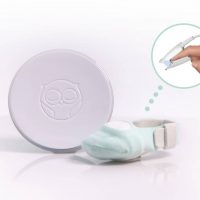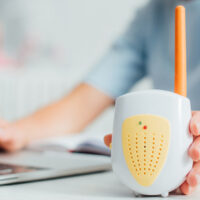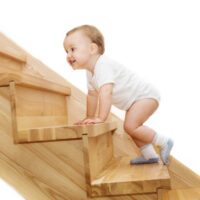Kiddie pools are a great way for your little one to exercise and cool off during the warmer months. However, without proper cleaning, kiddie pools become a breeding ground for the growth of algae and bacteria that can make your child sick. Fortunately, maintaining a kiddie pool is rather easy if you keep up on it.
Steps for Keeping the Kiddie Pool Clean
Step 1: Maintaining Debris
Outdoor pools might collect everything from dirt, sticks, and leaves to debris left from bugs, pets, and animals. You should empty smaller kiddie pools at the end of each day unless you have a cover. Even smaller pools pose a drowning hazard for young children and wildlife might get inside them. Flip the pool over when it is emptied to stop rainwater and debris from getting inside or store the pool inside a garage or shed when it’s not in use. (Be sure the pool dries before you store it to prevent mildew).
You should invest in a cover for larger inflatable pools. Use a skimmer to remove leaves and debris every night before closing the pool and before using it.
Something else you can do to reduce debris is to keep a container of water (big enough for your child’s feet) next to the pool. Then, they can rinse their feet of grass, dirt, or mud they might pick up in the backyard.
If your pool is in the sun, you may also want to invest in Scum Balls if you don’t plan on emptying the water every day. Scum Balls absorb oil from sunscreen, makeup, lotions, and other products you might use in your hair or skin, which lengthens the time between cleanings.
Step 2: Emptying the Kiddie Pool
Unless your pool has a filter, it will need to be emptied regularly to remove debris that you can’t get out with a pool skimmer like skin cells and fine particles of dirt. This will give you a chance to wash the bottom and sides of the pool and remove any algae or bacterial growth.
For smaller kiddie pools, you’ll want to empty them every day. If you’re worried about water waste, you can use the excess water in your garden or on the lawn. (This is only a good idea because you should not use chemicals in smaller kiddie pools, so there isn’t anything that will harm your lawn or plants).
For a medium-sized kiddie pool (think around 10-ft. or larger), you’ll want to drain the water once it becomes discolored, slimy, or you notice things floating in it. Backyard pools can become breeding grounds for mosquito larvae, so you’ll want to watch for that as well. As a general rule of thumb, you should drain at least once per week.
To drain larger pools, you can push down the side or let some air out if it is inflatable to drain some water before tipping it. Alternatively, use a pump to remove water.
Step 3: Washing the Kiddie Pool
For the next step, you’ll need a rag or cloth and some soap. You can also use a pool scrub brush, particularly if you have a bigger sized pool. Use some soapy water and rub all the sides to remove any stuck-on debris, algae, or bacteria. Then, rinse the area and let it dry completely before filling it again. You won’t need to wash the kiddie pool every day, just any time that you notice stuck-on debris. If you make sure the pool is clean before filling it with water, it’s less likely to get slimy or grow bacteria right away.
If algae are hard to remove with soap, two household products that work well to scrub away without being too abrasive are boraxand baking soda. You can use either of these products to make a paste by adding just a little water until you have a thick measure. Use this to scrub hard to clean parts of the swimming pool. Then, rinse and dry as you would normally.
In addition to washing the pool, it’s important that it has time to dry completely. This is especially true if you won’t be refilling it for a few days since any moisture can cause mildewing. One of the best ways to dry the pool is to set it out in the sun if possible. The sun should dry it quickly and as an added benefit, after a few hours, it kills germs, too. If you cannot set it in the sun, use a towel to wipe it dry after cleaning.
Step 4: How to Keep Kiddie Pool Water Clean Between Washes
If you have a larger kiddie pool, you can add chemicals to the water to maintain the level of cleanliness. Since you won’t be emptying it as often, you reduce water waste and save time. Something to note is that certain chemicals can damage grass and plants. You’ll want to keep the pool somewhere you don’t mind ruining the grass and you won’t want to use the pool water on your grass or plants.
Some of the chemicals that you can use in kiddie pools include:
- Chlorine- You can use chlorine for small pools or bleach in small quantities to prolong the use of smaller pools. It’s important not to add too much, a little bit goes a long way for sanitation. For example, you can add 1/16th cup (or 1 tablespoon) of chlorine bleach. You can find a useful chart on how much bleach to put in a kiddie pool here. Another alternative is hot tub/small pool chlorine tabs. These are about 1″ inside. You’ll put them inside a floating dispenser and it releases pool slowly over the week.
- Vinegar- Vinegar is another good alternative to reduce how often you change the water in your pool. (It is also a weed and grass killer, though, so you’ll want to use caution). The amount of vinegar you need depends on the pool. For a smaller kiddie pool, you might only need 1/4 cup to 1/2 cup of vinegar.
- Bromine- Bromine is another alternative to chlorine. It is used less often because it cannot be balanced out with cyanuric acid the same way that chlorine can. This is important for reducing the effect of UV rays, which quickly deplete levels of bromine and chlorine. Bromine also doesn’t oxidize as well as chlorine, so it is slightly less effective. However, it isn’t as irritating as chlorine and can be a good alternative for people who have sensitivity or allergies.
Step 5: Testing the Water Quality
If you decide to use chemicals in the pool, you’ll need to test the water quality regularly. This prevents adding too many chemicals (which can cause respiratory and skin problems) and helps monitor the number of chemicals in the pool so you know when to add more. You’ll need to do this because most smaller pools don’t have a filter, so the smaller bits of debris that you can’t remove using up a lot of the chemicals and it’s hard to track without testing.
Test strips measure things like level of chlorine, bromine, pH, and other factors that affect how clean and safe the water is. (Our top choice is AquaChek 7-Way 100 Count Test Strips).
Step 6: Analyzing Test Strips and Adjusting Levels
When adding any chemicals to the pool, you need to know how many gallons of water is in it. Once you know the number of gallons, you’ll want to refer to the manufacturer’s instructions for the chemical as to how much you need to add. Following the instructions is important because pool cleaning chemicals might have different concentrations depending on the brand you buy.
For smaller pools, your biggest things to consider are pH and the level of the chemical you’ve chosen to use. The range of each chemical starts at 0, which means there isn’t any in the pool. If there is too much of any chemical, you shouldn’t use the pool until the concentration comes down. You can do this by emptying some of the water or waiting for it to come down naturally over time.
The ideal levels of the chemicals you might add to your pool include:
- FCl (Free Chlorine)- 1-3ppm
- Bromine- 3-5ppm
- Cyanuric Acid- 30-50ppm
Bromine is used as an alternative to chlorine sometimes, while cyanuric acid is added with chlorine to prevent a UV-reaction from the sun that rapidly depletes chlorine levels. If you use stabilized chlorine, it likely already has cyanuric acid in it.
pH Levels
The ideal pH level of a pool is between 7.2 and 7.8. Anything under 7 is acidic and being out of range makes chlorine significantly less effective. Higher pH levels make it more likely that bacteria will grow, too. It is natural for pH levels to rise with use, so you should test the pool each time it is used and add dry acid if the pH levels are above 7.6.
Calcium Hardness and Alkalinity
You’ll also notice amounts for alkalinity and calcium hardness. Alkalinity and calcium hardness can damage pool equipment, but this isn’t as much of a risk with kiddie pools as it is with large swimming pools and spas. Additionally, the water is less likely to have calcium hardness or high alkalinity if it is being changed regularly. The ideal range for alkalinity is 80-120ppm and calcium hardness is 180-220ppm.
FAQs about Keeping a Kiddie Pool Clean
Why is it important to keep kiddie pool water clean?
Any type of water that your child plays in should be cleaned. Dirty water causes health problems including ears, nose, and throat irritation or gastroenteritis, which is caused by swallowing bacteria and might result in diarrhea and vomiting.
Kiddie pools are also breeding grounds for bacteria since they don’t have filters, especially if you choose not to use chemicals in them. Mosquitos may lay eggs in them and backyard critters might get debris in them. You’ll want to monitor the water and change it any time it has a different appearance than the day before. Some things to watch for include sliminess on the bottom or walls of the pool, visible discoloration or cloudiness, or things floating in the water.
How should I clean a kiddie pool if a kid poops or vomits in it?
The biggest risk when a child poops or vomits in a kiddie pool is bacteria. Kids should stay out of the pool when they are sick and younger kids should wear swim diapers. Even then, however, accidents can happen. If they do, you’ll want to have everyone in the pool exit immediately and clean it.
Start by putting on a pair of gloves and removing any visible matter that you can. Put it in a plastic bag so you can flush it down the toilet or dispose of it.
Next, you’ll want to drain any water from the pool so it can be cleaned. Use soapy water and a rag or brush to wash all areas of the pool. Then, rinse it clean completely with fresh water. Set the pool in the sun to dry.
After the pool is dry, you’ll want to disinfect it. The CDC recommends using diluted household (not splash-less) bleach. Combine 1 gallon of room temperature water with 1/2 cup bleach and use it to wipe down the surfaces of the pool. For an added measure, you can leave the pool out in the sun for 4 hours.
How often should pool water be changed?
There are many factors that affect how often pool water should be changed. Everything from the weather to how often the pool is used changes how clean the water is. Additionally, you’ll want to consider the location of the pool and how much debris gets into it through the day.
If you do not have testing strips, the best way to check water health is to monitor it closely. Use your hand to wipe the inside each day and check for sliminess. You should also look for excessive debris in the water or any kind of discoloration or cloudiness.
Ideally, you’ll want to change pool water before it gets to this state. Once you do choose a location for the pool, monitor the water for changes and make note of it. Try to change the pool water a day or two before these problems start showing up.
What can I use instead of a pool cover?
For some kiddie pools, it is nearly impossible to find a pool cover that fits. This is especially true for smaller kiddie pools or ones that have a unique shape. Instead of a pool cover, you can use a tarp and bungee cords or rope.
There are several ways that you can set up the cover. Something to keep in mind is that you’ll need a good fit for the pool cover to be effective. You want to leave as small of a gap between the cover and pool as possible to stop bugs and dirt from getting into the pool at night.
Can my dog use a kiddie pool?
Kiddie pools also make a great investment for keeping dogs cool in the summertime, especially if they love water. Something to keep in mind is that dogs often have a lot of pet dander and hair that is going to fall off in the pool. If you are going to let your dog in the kiddie pool, you’ll want to change the water after. You’ll also want to be sure you choose a kiddie pool that is durable enough to withstand their sharp nails and rough play. You can find our list of best kiddie pools (including a dog pool that’s great for kids and dogs).
Final Word
Practicing safe swimming is only part of ensuring that your little one stays safe while playing this summer. You’ll also need to safely maintain their kiddie pool water, whether you use pool chemicals or change it frequently. Hopefully, these tips have been helpful to parents wondering how to keep kiddie pool water clean.






